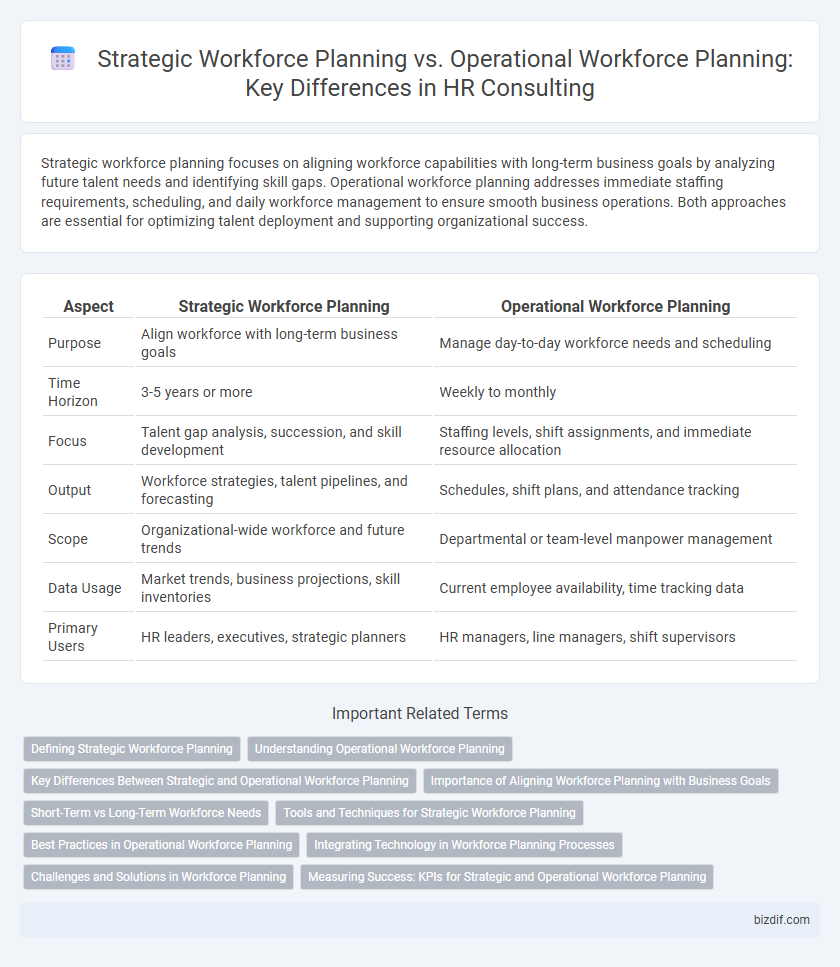Strategic workforce planning focuses on aligning workforce capabilities with long-term business goals by analyzing future talent needs and identifying skill gaps. Operational workforce planning addresses immediate staffing requirements, scheduling, and daily workforce management to ensure smooth business operations. Both approaches are essential for optimizing talent deployment and supporting organizational success.
Table of Comparison
| Aspect | Strategic Workforce Planning | Operational Workforce Planning |
|---|---|---|
| Purpose | Align workforce with long-term business goals | Manage day-to-day workforce needs and scheduling |
| Time Horizon | 3-5 years or more | Weekly to monthly |
| Focus | Talent gap analysis, succession, and skill development | Staffing levels, shift assignments, and immediate resource allocation |
| Output | Workforce strategies, talent pipelines, and forecasting | Schedules, shift plans, and attendance tracking |
| Scope | Organizational-wide workforce and future trends | Departmental or team-level manpower management |
| Data Usage | Market trends, business projections, skill inventories | Current employee availability, time tracking data |
| Primary Users | HR leaders, executives, strategic planners | HR managers, line managers, shift supervisors |
Defining Strategic Workforce Planning
Strategic Workforce Planning involves analyzing long-term organizational goals to forecast future talent needs and align workforce capabilities accordingly. It integrates market trends, business growth projections, and skill gap analysis to develop proactive hiring and development strategies. This approach ensures the organization maintains a competitive advantage by anticipating changes in labor demand and supply.
Understanding Operational Workforce Planning
Operational Workforce Planning centers on managing day-to-day employee scheduling, task allocation, and ensuring workforce availability aligns with immediate business demands. It involves monitoring employee performance, handling shift rotations, and addressing short-term staffing gaps to maintain smooth operational flow. Effective implementation improves productivity, reduces overtime costs, and supports responsive adjustments to fluctuating workload requirements.
Key Differences Between Strategic and Operational Workforce Planning
Strategic Workforce Planning focuses on long-term goals, analyzing future talent needs aligned with business strategy, while Operational Workforce Planning addresses immediate staffing requirements and daily workforce management. Strategic planning involves forecasting workforce trends, skill gaps, and succession planning, whereas operational planning manages scheduling, shift allocation, and short-term resource deployment. These key differences enable organizations to balance future readiness with current operational efficiency in HR consulting.
Importance of Aligning Workforce Planning with Business Goals
Aligning strategic and operational workforce planning with business goals ensures optimal resource allocation and drives organizational performance. Strategic workforce planning anticipates future talent needs based on long-term objectives, while operational planning focuses on short-term workforce management and immediate staffing requirements. Synchronizing these approaches enables agile responses to market changes, reduces talent gaps, and supports sustainable growth.
Short-Term vs Long-Term Workforce Needs
Strategic Workforce Planning focuses on long-term workforce needs by aligning talent acquisition and development with future business goals over a multi-year horizon. Operational Workforce Planning addresses short-term workforce demands, managing daily staffing requirements and immediate resource allocation to maintain productivity. Balancing both approaches ensures organizations remain agile while preparing for sustainable growth and changing market conditions.
Tools and Techniques for Strategic Workforce Planning
Strategic Workforce Planning employs advanced analytics, predictive modeling, and scenario planning tools to forecast talent needs aligned with organizational goals. Techniques such as competency mapping, labor market analysis, and workforce segmentation help in identifying critical skill gaps and future workforce risks. These tools facilitate data-driven decision-making to optimize talent acquisition, development, and retention strategies.
Best Practices in Operational Workforce Planning
Effective operational workforce planning prioritizes real-time data analysis and adaptability to meet immediate staffing needs while minimizing labor costs. Best practices include leveraging integrated HR technology systems for accurate demand forecasting and implementing continuous communication channels between HR, management, and employees to rapidly address skill gaps. Emphasizing scenario planning and flexible scheduling enhances responsiveness to fluctuating workloads and ensures optimal resource allocation aligned with operational goals.
Integrating Technology in Workforce Planning Processes
Strategic workforce planning leverages advanced analytics and AI-driven platforms to forecast long-term talent needs and align workforce capabilities with business goals. Operational workforce planning utilizes real-time data and automated scheduling tools to optimize daily staffing, ensuring efficient resource allocation and productivity. Integrating technology across both levels enhances decision-making accuracy, supports scalability, and enables seamless adaptation to evolving market demands.
Challenges and Solutions in Workforce Planning
Strategic Workforce Planning faces challenges such as aligning long-term business goals with talent acquisition and predicting future skill requirements amidst market volatility. Operational Workforce Planning struggles with managing day-to-day staffing needs and optimizing resource allocation to maintain productivity. Implementing data-driven forecasting tools and integrating real-time labor market analytics enhance decision-making and bridge the gap between strategic vision and operational execution.
Measuring Success: KPIs for Strategic and Operational Workforce Planning
Measuring success in Strategic Workforce Planning (SWP) involves KPIs such as talent gap closure rate, alignment of workforce capabilities with long-term business goals, and future workforce cost efficiency. Operational Workforce Planning (OWP) success is tracked through KPIs including employee productivity rates, real-time staffing levels, and turnover rates within key operational roles. Distinguishing these KPIs ensures that strategic initiatives drive future readiness while operational metrics optimize day-to-day workforce performance.
Strategic Workforce Planning vs Operational Workforce Planning Infographic

 bizdif.com
bizdif.com